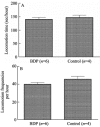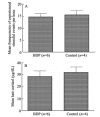A natural model of behavioral depression in postpartum adult female cynomolgus monkeys (Macaca fascicularis)
- PMID: 24866487
- PMCID: PMC5055539
- DOI: 10.11813/j.issn.0254-5853.2014.3.174
A natural model of behavioral depression in postpartum adult female cynomolgus monkeys (Macaca fascicularis)
Abstract
Postpartum depression (PPD) is a modified form of major depressive disorders (MDD) that can exert profound negative effects on both mothers and infants than MDD. Within the postpartum period, both mothers and infants are susceptible; but because PPD typically occurs for short durations and has moderate symptoms, there exists challenges in exploring and addressing the underlying cause of the depression. This fact highlights the need for relevant animal models. In the present study, postpartum adult female cynomolgus monkeys (Macaca fascicularis) living in breeding groups were observed for typical depressive behavior. The huddle posture behavior was utilized as an indicator of behavioral depression postpartum (BDP) as it has been established as the core depressive-like behavior in primates. Monkeys were divided into two groups: A BDP group (n=6), which were found to spend more time huddling over the first two weeks postpartum than other individuals that formed a non-depression control group (n=4). The two groups were then further analyzed for locomotive activity, stressful events, hair cortisol levels and for maternal interactive behaviors. No differences were found between the BDP and control groups in locomotive activity, in the frequencies of stressful events experienced and in hair cortisol levels. These findings suggested that the postpartum depression witnessed in the monkeys was not related to external factors other than puerperium period. Interestingly, the BDP monkeys displayed an abnormal maternal relationship consisting of increased infant grooming. Taken together, these findings suggest that the adult female cynomolgus monkeys provide a natural model of behavioral postpartum depression that holds a number of advantages over commonly used rodent systems in PPD modeling. The cynomolgus monkeys have a highly-organized social hierarchy and reproductive characteristics without seasonal restriction-similar to humans-as well as much greater homology to humans than rodents. As such, this model may provide a greater translational efficiency and research platform for systematically investigating the etiology, treatment, prevention of PPD.
Keywords: Cynomolgus monkeys; Hair cortisol; Huddle behavior; Locomotion activity; Maternal relationship; Postpartum depression; Stressful events.
Figures




Similar articles
-
Detection of anxiety and depression-like behavior and intra-brain pathological markers in Parkinsonian cynomolgus monkeys.Exp Neurol. 2025 Jul;389:115242. doi: 10.1016/j.expneurol.2025.115242. Epub 2025 Apr 5. Exp Neurol. 2025. PMID: 40194648
-
Behavioral depression and positron emission tomography-determined serotonin 1A receptor binding potential in cynomolgus monkeys.Arch Gen Psychiatry. 2006 Apr;63(4):396-403. doi: 10.1001/archpsyc.63.4.396. Arch Gen Psychiatry. 2006. PMID: 16585468
-
Chronic mild stress leads to aberrant glucose energy metabolism in depressed Macaca fascicularis models.Psychoneuroendocrinology. 2019 Sep;107:59-69. doi: 10.1016/j.psyneuen.2019.05.007. Epub 2019 May 10. Psychoneuroendocrinology. 2019. PMID: 31108306
-
Modeling depression in adult female cynomolgus monkeys (Macaca fascicularis).Am J Primatol. 2012 Jun;74(6):528-42. doi: 10.1002/ajp.21013. Epub 2011 Nov 10. Am J Primatol. 2012. PMID: 22076882 Review.
-
Maternal separation: Does it hold the potential to model consequences of postpartum depression?Dev Psychobiol. 2022 Jan;64(1):e22219. doi: 10.1002/dev.22219. Dev Psychobiol. 2022. PMID: 35050513 Review.
Cited by
-
A systematic review of studies utilizing hair glucocorticoids as a measure of stress suggests the marker is more appropriate for quantifying short-term stressors.Sci Rep. 2019 Aug 19;9(1):11997. doi: 10.1038/s41598-019-48517-2. Sci Rep. 2019. PMID: 31427664 Free PMC article.
-
Behavioral depression is associated with increased vagally mediated heart rate variability in adult female cynomolgus monkeys (Macaca fascicularis).Int J Psychophysiol. 2018 Sep;131:139-143. doi: 10.1016/j.ijpsycho.2017.11.004. Epub 2017 Nov 8. Int J Psychophysiol. 2018. PMID: 29128294 Free PMC article.
-
The Faster-Onset Antidepressant Effects of Hypidone Hydrochloride (YL-0919) in Monkeys Subjected to Chronic Unpredictable Stress.Front Pharmacol. 2020 Nov 26;11:586879. doi: 10.3389/fphar.2020.586879. eCollection 2020. Front Pharmacol. 2020. PMID: 33324217 Free PMC article.
-
Abnormality of anxious behaviors and functional connectivity between the amygdala and the frontal lobe in maternally deprived monkeys.Brain Behav. 2023 Sep;13(9):e3027. doi: 10.1002/brb3.3027. Epub 2023 Jul 18. Brain Behav. 2023. PMID: 37464725 Free PMC article.
-
Experimental primates and non-human primate (NHP) models of human diseases in China: current status and progress.Dongwuxue Yanjiu. 2014 Nov 18;35(6):447-64. doi: 10.13918/j.issn.2095-8137.2014.6.447. Dongwuxue Yanjiu. 2014. PMID: 25465081 Free PMC article. Review.
References
-
- Abbott DH, Keverne EB, Bercovitch FB, Shively CA, Mendoza SP, Saltzman W, Snowdon CT, Ziegler TE, Banjevic M, Garland T, Sapolsky RM. 2003. Are subordinates always stressed? A comparative analysis of rank differences in cortisol levels among primates. Hormones and Behavior, 43 (1): 67- 82. - PubMed
-
- Bloch M, Schmidt PJ, Danaceau M, Murphy J, Nieman L, Rubinow DR. 2000. Effects of gonadal steroids in women with a history of postpartum depression. American Journal of Psychiatry, 157 (6): 924- 930. - PubMed
-
- Bowlby J. 1962. Attachment and Loss. New York: Basic Books,
-
- Brummelte S, Galea LAM. 2010. Depression during pregnancy and postpartum: contribution of stress and ovarian hormones. Progress in Neuro-Psychopharmacology and Biological Psychiatry, 34 (5): 766- 776. - PubMed
-
- Burke HM, Davis MC, Otte C, Mohr DC. 2005. Depression and cortisol responses to psychological stress: a meta-analysis. Psychoneuroendocrinology, 30 (9): 846- 856. - PubMed
Publication types
MeSH terms
Substances
LinkOut - more resources
Full Text Sources
Medical
Research Materials
